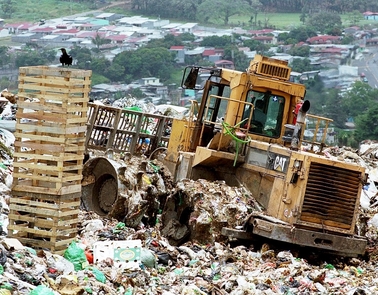
Engineering landfills to save money, resources
Posted: August 20, 2010

Engineering professor Edward Kavazanjian’s research focuses on cost-effective ways to maximize the use of landfills. (stock.xchng photo)
Being able to determine precisely how much solid waste can be safely contained in the landfills where much of our trash is deposited is critical to protecting the environment – and a big money saver.
For more than a decade, Arizona State University engineering professor Edward Kavazanjian has been working on ways to make landfills more economically and environmentally sustainable by bringing a high degree of precision to the assessment of such capacity and safety factors.
Some of his findings are detailed in a technical paper that has won the 2010 Thomas A. Middlebrooks Award, a top honor from the American Society of Civil Engineers for research papers in the geotechnical engineering field.
The findings “should have broad application around the world in evaluating landfill safety and capacity,” said Kavazanjian, a professor in the School of Sustainable Engineering and the Built Environment, One of ASU’s Ira A. Fulton Schools of Engineering.
Kavazanjian and his co-authors will be presented the research paper award in March of next year in Dallas at Geo-Frontiers, a national conference showcasing significant advances in geotechnical engineering.
The research paper focuses on what professionals call municipal solid waste, which is the garbage we typically put in containers and take out to the curb each week for pickup. Most of this kind of waste ends up in municipal landfills.
Knowing how high and how steeply the waste can be safely piled into a landfill helps reduce the need for – and the costs of – new or expanded landfills. Using landfills to full capacity helps keep costs for public waste disposal from increasing, thus keeping our monthly waste-hauling bills down.
The paper Kavazanjian co-wrote with several colleagues provides information essential to maximizing landfill capacity.
The research was conducted as part of project funded by the National Science Foundation that joined engineers at ASU, the University of California-Berkeley and the University of Texas-Austin. The award-winning research paper represents the culmination of 15 years of study by Kavazanjian and his colleagues.
His co-authors are: former Berkeley graduate student Demetrios Zekkos, now an assistant professor of civil engineering at the University of Michigan; Jonathan Bray, professor of civil engineering, and Mike Riemer, an adjunct civil engineering professor, both at Berkeley; and George Athanasopoulos, a civil engineering professor at the University of Patras in Greece.
The group’s work built on a research paper by Kavazanjian published in 1995 in which he suggested that municipal solid waste was generally stronger than assumed by most engineers in their engineering analyses. The assumed strength of the waste is one of the critical factors in determining landfill capacity. It governs how steep the landfill slopes can be formed.
The recommendations for waste strength published by Kavazanjian in 1995 have contributed to the construction of cost-effective large regional landfills with high capacities.
The new research paper documents progress in the studies of the engineering properties of municipal solid waste and demonstrates that landfills can be safely designed using waste strengths 5 to 10 percent more than the levels recommended in the 1995 report.
The conclusions have been verified by extensive lab testing, some performed in ASU’s Enamul Hoque Geotechnical Laboratory.



































